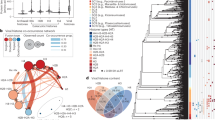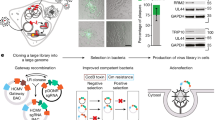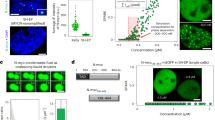Abstract
HUMAN adenovirus 2(Ad2), a DNA tumour virus that replicates in the nucleus of permissive human cells1,2, transforms non-permissive or semipermissive cultured rodent cells, but does not induce tumours in newborn hamsters (oncogenic group C). The constant functioning of protein product(s) from Ad2 ‘transforming gene(s)’ is probably responsible for the transformed phenotype, although this has not been proved. Identification and functional characterisation of ‘transforming protein(s)’ are important for the understanding of cell transformation and growth control. We describe here immunoprecipitation studies made with antisera against presumptive Ad2 ‘transforming protein(s)’, that identify two candidate transforming proteins of 53,000 (53k) and 15kdaltons.
This is a preview of subscription content, access via your institution
Access options
Subscribe to this journal
Receive 51 print issues and online access
$199.00 per year
only $3.90 per issue
Buy this article
- Purchase on Springer Link
- Instant access to full article PDF
Prices may be subject to local taxes which are calculated during checkout
Similar content being viewed by others
References
Philipson, L., Pettersson, U., and Lindberg, U., in Virol. Monogr., 14 (edit. by Gard, S., and Hallauer, C.), 1–115 (Springer, New York, 1975).
Wold, W. S. M., Green, M., and Büttner, W., in The Molecular Biology of Animal Viruses (edit. by Nayak, D. P.). (Dekker, New York, in the press).
Green, M., et al., Cold Spring Harb. Symp. quant. Biol., 35, 803–818 (1970).
Gallimore, P. H., Sharp, P. A., and Sambrook, J., J. molec. Biol., 89, 49–72 (1974).
Flint, S. J., Gallimore, P. H., and Sharp, P. A., J. molec. Biol., 96, 47–68 (1975).
Graham, F. L., et al., Cold Spring Harb. Symp. quant. Biol., 39, 637–650 (1974).
Gilden, R. V., et al., Nature, 219, 517–518 (1968).
Harter, M. L., Shanmugam, G., Wold, W. S. M., and Green, M., J. Virol., 19, 232–241 (1976).
Gilead, Z., Arens, M. Q., Bhaduri, S., Shanmugam, G., and Green, M., Nature, 254, 533–536 (1975).
Gilead, Z., Sugawara, K., Shanmugam, G., and Green, M., J. Virol., 18, 454–460, (1976).
Rosenwirth, B., Anderson, C., and Levine, A. J., Virology, 69, 617–625 (1976).
Saborio, J. L., and Öberg, B., J. Virol., 17, 865–875 (1976).
Lewis, J. B., et al., Cell, 7, 141–151 (1976).
Penman, S., in Fundamental Techniques in Virology (edit. by Habel, K., and Salzman N. P.), 35–48 (Academic, New York and London, 1969).
Gielkens, A. L. J., Van Zaane, D., Bloemers, H. P. J., and Bloemendal, H., Proc. natn. Acad. Sci. U.S.A., 73, 356–360 (1976).
Bonner, W. M., and Laskey, R. A., Eur. J. Biochem., 46, 83–88 (1974).
Author information
Authors and Affiliations
Rights and permissions
About this article
Cite this article
GILEAD, Z., JENG, YH., WOLD, W. et al. Immunological identification of two adenovirus 2-induced early proteins possibly involved in cell transformation. Nature 264, 263–266 (1976). https://doi.org/10.1038/264263a0
Received:
Accepted:
Issue Date:
DOI: https://doi.org/10.1038/264263a0
This article is cited by
-
Transformation of cotton (Gossypium hirsutum L.) by Agrobacterium tumefaciens and regeneration of transgenic plants
Plant Molecular Biology (1987)
-
Insertion of N regions into heavy-chain genes is correlated with expression of terminal deoxytransferase in B cells
Nature (1984)
-
Purification of measles virus H polypeptide and of F polypeptide
Archives of Virology (1981)
-
Immunochemical properties of antigens present on immature erythrocytes from mouse and rat
Blut (1981)
Comments
By submitting a comment you agree to abide by our Terms and Community Guidelines. If you find something abusive or that does not comply with our terms or guidelines please flag it as inappropriate.



